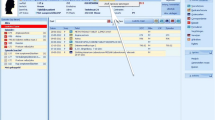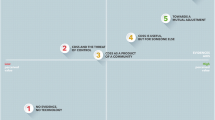Abstract
Objective
While developing the patient data management system ICUData in close cooperation with the software company (IMESO GmbH, Hüttenberg, Germany), a therapeutic guideline assistance system for empiric antimicrobial therapy in ICU (called “Antibiotic Wizard”) could be introduced and integrated into the existing software. After its introduction into clinical routine, the first version was to be tested, checked for usability and compared to other software products with the help of the IsoMetricss inventory (based on the EN ISO 9241-10 for computer-assisted workflows).
Methods
Half a year after introducing the “Antibiotic Wizard” in the ICUs, 40 physicians from different specialties at different levels of training were surveyed in order to detect deficiencies in the use of the program. The results of these surveys were compared to surveys on the word processing software Word® for Windows® (WinWord®) from Microsoft®, the hospital information system IS-H*MED from SAP® (online and paper surveys) and the administrative program, SAP R/3 HR, also from SAP®.
Results
Reliabilities (Cronbach’s Alpha) of the subscales ranged from satisfactory (α > 0.70) to good (α > 0.80), except for “Controllability” (α = 0.663) and “Error tolerance” (α = 0.693). Medians for individual subscales ranged between 3.04 (“Error tolerance”) and 3.96 (“Suitability for learning”). The “Antibiotic Wizard” showed significantly better results compared to both IS-H*MED and SAP R/3 HR in the subscales of “Suitability for the task”, “Self-descriptiveness” and “Suitability for learning”. In contrast, “Self-descriptiveness” “Controllability” and “Error tolerance” were significantly worse compared to WinWord®.
Conclusions
In generally, the usability of the “Antibiotic Wizard” was deemed good. Some weaknesses were found in the fields of “Error tolerance” and “Controllability”. These problems will be corrected in future versions.
Similar content being viewed by others
References
Berg M, Langenberg C, vd B I, Kwakkernaat J Considerations for sociotechnical design: experiences with an electronic patient record in a clinical context. Int.J Med.Inform. 1998;52:243–251
Williams LS. Microchips versus stethoscopes: Calgary hospital, MDs face off over controversial computer system. CMAJ 1992;147:1534–1547
Holz auf der Heide B Welche software-ergonomischen evaluationsverfahren können was leisten? In: Rödiger KH (ed) Software-ergonomie ‚93, Von der benutzeroberfläche zur arbeitsgestaltung. Teubner, Stuttgart; 1993:157–172
Oppermann R, Reiterer H Software-ergonomische evaluation. In: Eberleh E, Oberquelle H, Oppermann R (eds) Einführung in die software-ergonomie. Walter de Gruyter, Berlin; 1994:335–371
Dzida W. Software-ergonomische Qualitätsprüfung - Utopie oder realistisches Ziel? In: Cakir A, Cakir G, eds., Was bringen die europäischen Regelwerke für Bildschirmarbeitsplätze? Berlin: 1991:61–76
Eason KD. Towards experimental study of usability. Behav Inf Technol 1984;3:133–143
Rauterberg M. Lässt sich die gebrauchstauglichkeit interaktiver software messen? Und wenn ja, wie? Ergonomie and Informatik. 1992;16:3–18
Michel A, Benson M, Junger A, Sciuk G, Hempelmann G, Dudeck J, Marquardt K. Design principles of a clinical information system for intensive care units (ICUData). Stud Health TechnolInf 2000;77:921–924
Gediga G, Hamborg KC, Düntsch I. The IsoMetrics usability inventory: an operationalization of ISO 9241-10 supporting summative and formative evaluation of software systems. Behav Inf Technol 1999;18:151–164
Hamborg KC, Vehse B, Bludau HB. Questionnaire based usability evaluation of hospital information systems. Elect J Inf Syst Eval 2004;7:21–30
Gruber C. Arbeitseffizienz im Büro. Psychische Einflüsse auf SAP R/3–unterstützte Arbeitsprozesse. Dissertation, Psychologisches Institut., Julius-Maximilians-Universität Würzburg, 2000:59–61
Vogel F, Bodmann K. Empfehlungen zur kalkulierten parenteralen Initialtherapie bakterieller erkrankungen bei erwachsenen. Chemotherapie J 2004;13:46–105.
Acknowledgments
We would like to thank MoReData GmbH in Giessen, Germany for their help in statistical analysis.
Financial support for this study was provided in part by a grant from IMESO GmbH, Hüttenberg, Germany. The founding agreement ensured the authors’ independence in designing the study, interpreting the data, writing and publishing the report.
Author information
Authors and Affiliations
Corresponding author
Additional information
Röhrig R, Beuteführ H, Hartmann B, Niczko E, Quinzio B, Junger A, Hempelmann G. Summative software evaluation of a therapeutic guideline assistance system for empiric antimicrobial therapy in ICU.
Rights and permissions
About this article
Cite this article
Röhrig, R., Beuteführ, H., Hartmann, B. et al. Summative Software Evaluation of a Therapeutic Guideline Assistance System for Empiric Antimicrobial Therapy in ICU. J Clin Monit Comput 21, 203–210 (2007). https://doi.org/10.1007/s10877-007-9073-0
Received:
Accepted:
Published:
Issue Date:
DOI: https://doi.org/10.1007/s10877-007-9073-0




